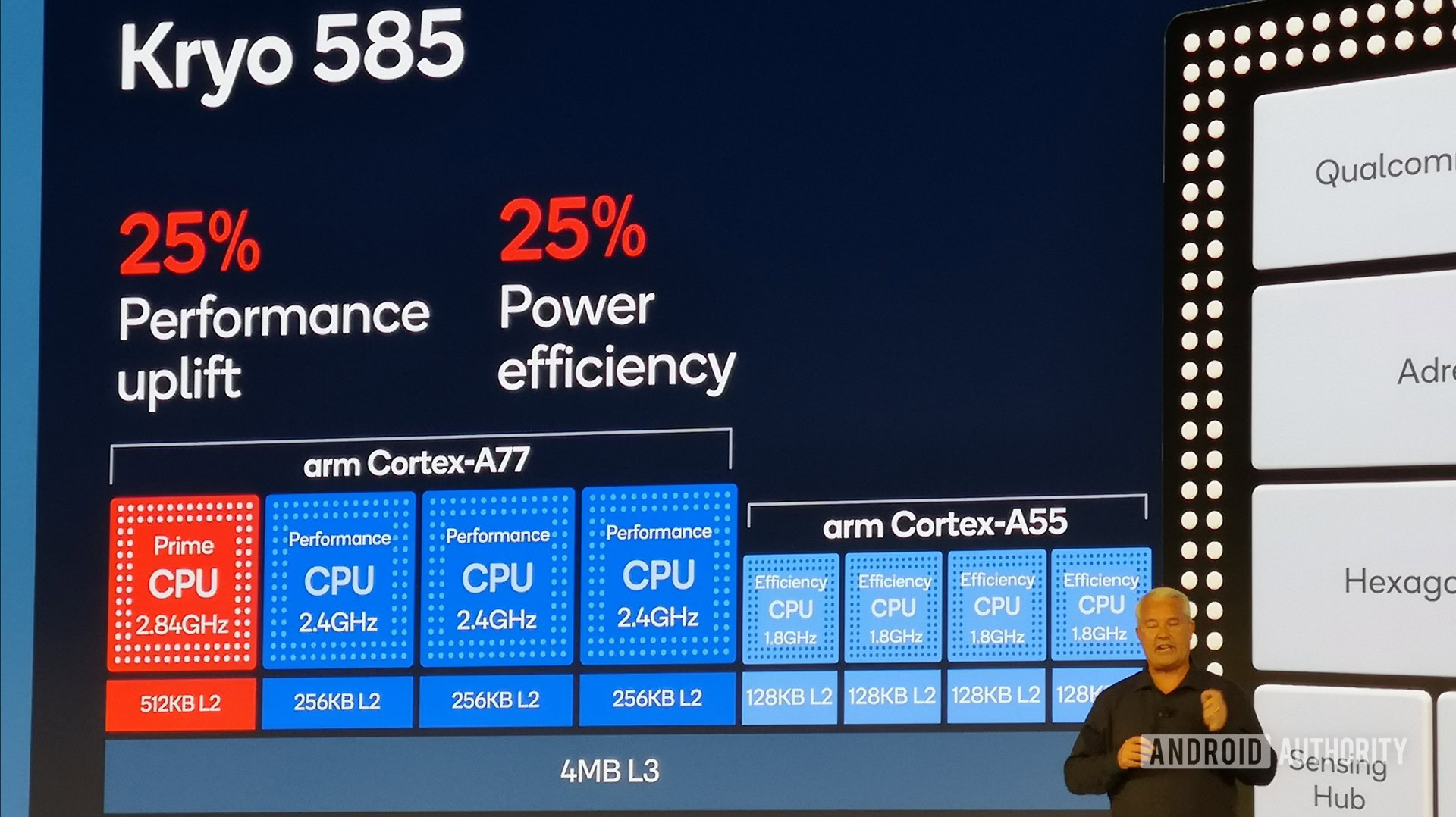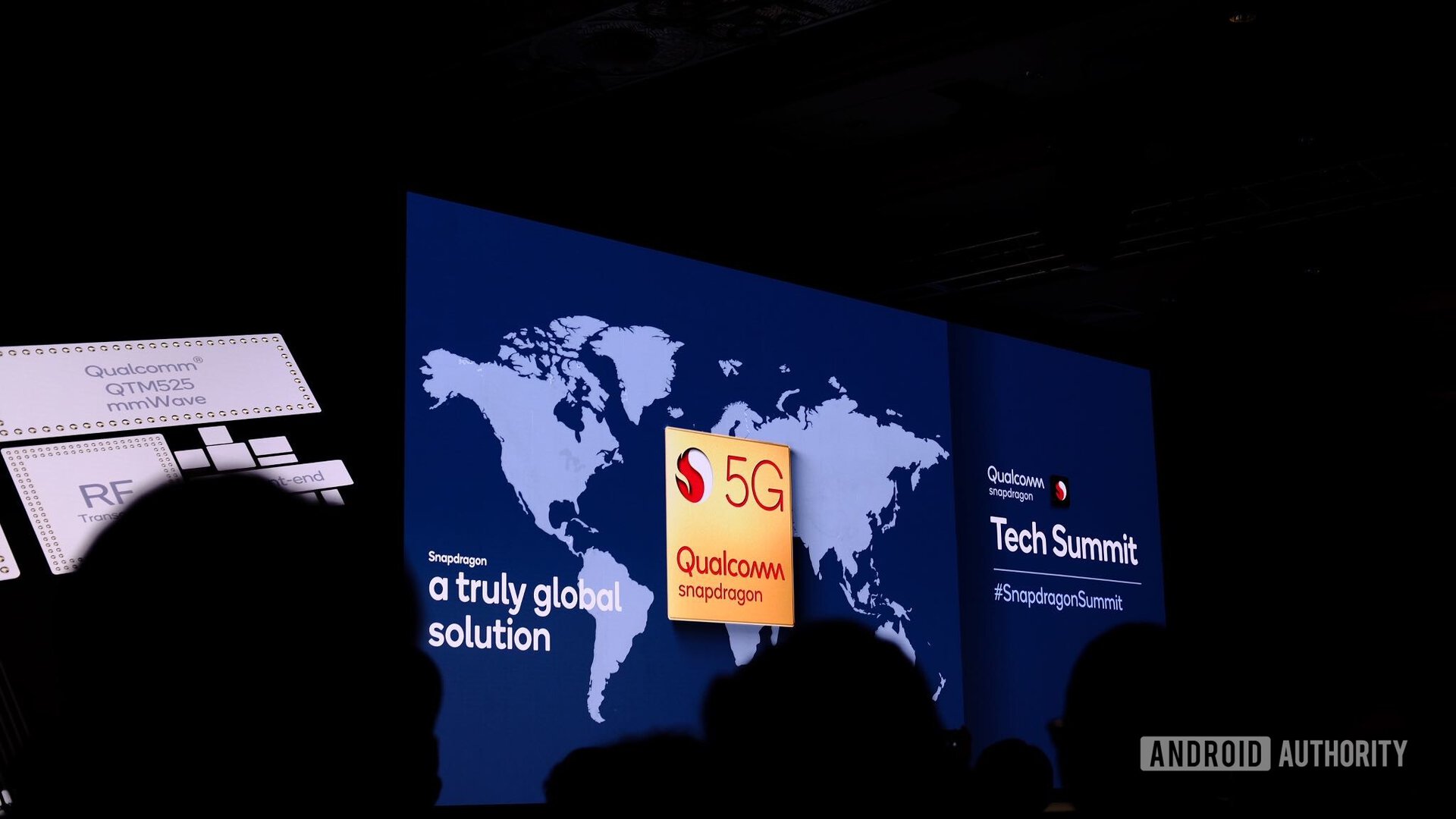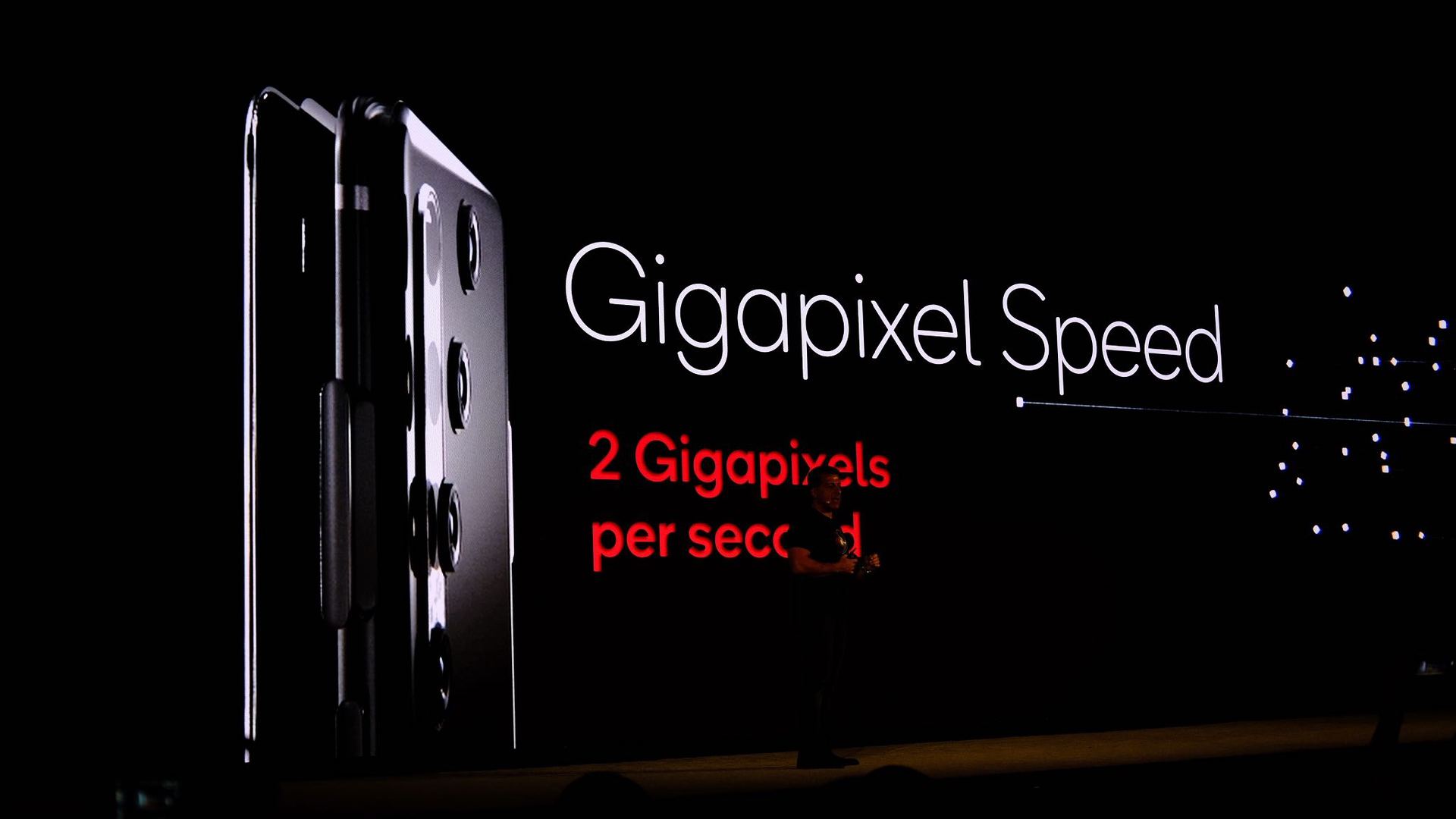Affiliate links on Android Authority may earn us a commission. Learn more.
Qualcomm Snapdragon 865: Everything you need to know

Following the official unveiling, today we’re diving deeper into the ins and outs of Qualcomm’s brand-new Snapdragon 865 mobile application processor. The Snapdragon 865 supplants 2018’s Snapdragon 855 as Qualcomm’s premium mobile application processor, boasting notable improvements to the smartphone industry’s hottest trends in gaming, AI, and photography.
For the quick takeaways, the Qualcomm Snapdragon 865 is built on TSMC’s 7nm FinFET process. General performance is up around 25%, energy efficiency improvements land in the 25% range from the 855, and Qualcomm has overhauled both its AI and imaging processor solutions. There’s still no 5G integrated modem inside the Snapdragon 865, although that’s not necessarily a big problem. This can probably be overlooked given the sheer amount of other improvements that have gone into the 865.
| Snapdragon 865 | Snapdragon 855 | Snapdragon 845 | |
|---|---|---|---|
CPU Config | Snapdragon 865 1x 2.84GHz (Cortex A77) 3x 2.4GHz (Cortex A77) 4x 1.8GHz (Cortex-A55) | Snapdragon 855 1x 2.84GHz (Cortex A76) 3x 2.42GHz (Cortex A76) 4x 1.8GHz (Cortex-A55) | Snapdragon 845 4x 2.8GHz (Cortex-A75) 4x 1.7GHz (Cortex-A55) |
GPU | Snapdragon 865 Adreno 650 | Snapdragon 855 Adreno 640 | Snapdragon 845 Adreno 630 |
DSP | Snapdragon 865 Hexagon 698 | Snapdragon 855 Hexagon 690 | Snapdragon 845 Hexagon 685 with HVX |
Process | Snapdragon 865 7nm FinFET | Snapdragon 855 7nm FinFET | Snapdragon 845 10nm LPP FinFET |
Camera support | Snapdragon 865 200MP single / 64MP single with Zero Shutter Lag 24MP dual camera Hybrid AF, HDR video. multi-frame noise reduction | Snapdragon 855 48MP single / 24MP dual Hybrid AF, HDR video. multi-frame noise reduction | Snapdragon 845 32MP single / 16MP dual Hybrid AF, HDR video. multi-frame noise reduction |
Video capture | Snapdragon 865 8K @ 30fps, 4K UHD @ 120fps, 720p @ 960fps | Snapdragon 855 4K UHD, HDR @ 60fps | Snapdragon 845 4K UHD @ 60fps |
Video playback | Snapdragon 865 8K, 360 degree, 4K up to 120fps, 10-bit, H.265 and VP9 video decoder | Snapdragon 855 8K, 360 degree, 4K up to 120fps, 10-bit, H.265 and VP9 video decoder | Snapdragon 845 4K UHD @ 60fps, 10-bit H.264 (AVC) and H.265 (HEVC) |
Charging | Snapdragon 865 Quick Charge 4+ Quick Charge AI | Snapdragon 855 Quick Charge 4+ | Snapdragon 845 Quick Charge 4+ |
Modem | Snapdragon 865 X55 5G & RF system 7500 Mbps down 3000 Mbps up | Snapdragon 855 X24 LTE 2000 Mbps down 316 Mbps up | Snapdragon 845 x20 LTE 1200 Mbps down 150 Mbps up |
Snapdragon 865 CPU and GPU deep dive
At the heart of every smartphone chipset is a CPU and GPU combo. You won’t find a more powerful duo than the Snapdragon 865’s Kryo 585 CPU and Adreno 650 GPU.
As with the Snapdragon 855, the Snapdragon 865 is built with a Prime, Performance, Efficiency octa-core CPU configuration. The largest prime core is an Arm Cortex-A77 clocked at 2.85GHz and paired with a 512kb L2 memory cache for peak performance. Three more big Cortex-A77 cores flank the prime core, offering 2.4GHz peak clock speeds and smaller 256kb L2 caches. The Cortex-A77 is the most powerful Arm CPU design to date, with more than enough power to run the most demanding apps and mobile games around. Neither the Kirin 990 nor Exynos 990 feature this CPU core — they’re based on the older Cortex-A76 (and Samsung’s custom M4 core in the Exynos’ case).
The smaller power efficiency cores are more familiar from last year. These are four Cortex-A55 cores with 128kb L2 caches and 1.8GHz clock speeds. It’s basically the same setup as last year. Overall, Qualcomm promises a 25% boost to both performance and power efficiency this generation.

On the gaming side, the Snapdragon 865 is equipped with an Adreno 650 GPU. Qualcomm promises a similar 25% performance gain for graphics rendering, with energy efficiency improved by 35% as well. There are new features for gamers in the Snapdragon Elite package, which include 144Hz for QHD+ resolution displays, 10-bit HDR gaming, Desktop Forward Rendering support in Unreal Engine 4 games, and GPU updates provided via Google Play.
The Adreno 650 GPU can be updated via the Google Play Store — a first for Android phones.
This last point is particularly interesting. Qualcomm has worked closely with Google to separate its Adreno GPU drivers from the rest of the system, allowing for simple updates over Google Play. New features, performance improvements, and even game optimizations can be delivered quickly, with no more hassle than updating an app. This brings mobile gaming another step closer to PC gaming.
Powering next-gen artificial intelligence

Smartphone machine learning (or AI) capabilities have come on leaps and bounds in the past couple of years, and Qualcomm is (quite literally) doubling down on its capabilities this generation.
The new Hexagon 698 DSP boasts a new Tensor accelerator specifically for machine learning workloads. This new part offers 4x TOPS performance and 35% better energy efficiency than Qualcomm’s previous Hexagon DSP, which introduced a dedicated Tensor accelerator to the Snapdragon 855.
However, machine learning is a system-wide solution for Qualcomm. The company calls this its AI Engine, which enters its fifth generation with the Snapdragon 865. To that end, the chipset includes a 3MB system cache, up from 2MB previously, and supports LPDDR5 2750MHz RAM to move data faster than before. This, combined with the CPU, GPU, and DSP/AI processing capabilities, results in a whopping 15TOPS of AI performance. That’s double what was on offer with the Snapdragon 855 and comfortably ahead of the competition.
Also read: What the Qualcomm Snapdragon 865 means for your next smartphone
5G

Although the industry is gradually moving towards integrated 5G modems, the Snapdragon 865, just like its predecessor, still requires an external modem for 5G connectivity. Qualcomm envisions that partners will pair the 865 up with the Snapdragon X55 5G modem. The Kirin 990, Exynos 990, and Snapdragon 765 feature integrated 5G components, although they’re easily half the speed of the X55. The X55 offers all the latest 5G bells and whistles, we’ll just have to wait another year for these to be integrated inside the SoC.
The Snapdragon X55 supports both mmWave and sub-6GHz spectrum, just like its predecessor. Theoretical peak speeds hit 7.6Gbps download and up to 3Gbps upload. However, you’ll need a perfect alignment of network conditions and capabilities to reach such lofty speeds. Other important features include 5G Standalone (SA) and Non-Standalone (NSA) network support, 5G FDD for Europe, 4G/5G spectrum sharing, and 100MHz envelope tracking. In other words, there’s everything you need here to get up and running on global 5G networks.
The Snapdragon 865 still requires an external modem for 5G connectivity.
Requiring an external modem has some drawbacks for power consumption. Integrated modems are simply more efficient, but Qualcomm is targeting maximum performance with the 865. Although given the X55 is Qualcomm’s second-generation 5G modem, the energy efficiency should be improved over the X50 that’s been used with Snapdragon 855 handsets. Qualcomm is also billing this as a complete 5G “modem to antenna” solution for the 865. Packaging radio power, frequency tuning, and antennas together with the modem for a one-stop 5G solution.
Read more: Why there’s no integrated 5G modem in the Snapdragon 865
Taking the perfect picture

Photography is a cornerstone of the modern smartphone experience, and a new processor wouldn’t be complete without some imaging improvements. The Snapdragon 865 makes some major changes to the image signal processor (ISP), producing notable new capabilities and features for users. These include support for up to 200MP camera sensors, 720p 960fps slow-motion video recording with no time limit, 8K 30fps video capture, on-device Dolby Vision HDR, and up to 64MP instant snaps while recording video.
Qualcomm has achieved this by changing the inner workings of its Spectra ISP. Rather than processing one pixel per clock cycle, the Spectra ISP now works on four pixels per cycle. As a result, Qualcomm has dropped the clock speed of the ISP to make major power savings, while still pushing performance up by 40% to two gigapixels per second. The power savings also mean a cooler ISP, and thus the ability to record 960fps with no time limits.
The Snapdragon 865 still has all the 855’s computer vision ISP capabilities, speeding up processing of HDR, scene detection, and noise reduction in low light. Combined with the 865’s other machine learning capabilities, 2020’s phones are set to be computational powerhouses. Be sure to check out our interview with Qualcomm’s Judd Heape, Senior Director of Product Management for all the ins and outs of the Snapdragon 865’s camera capabilities.
Snapdragon 865 in 2020 flagship phones
The Qualcomm Snapdragon 865 doesn’t disappoint performance enthusiasts. From a range of general performance improvements to dedicated AI, photography, and gaming features, the 865 excels at every demand you can throw at it. However, with the affordable flagship-tier Snapdragon 765 also offering excellent performance and 5G capabilities, the 865 is perhaps not the most industry-shifting chipset heading to the market next year.
The Snapdragon 865 will almost certainly power most of 2020’s high profile smartphone releases from Samsung, Google, OnePlus, and others. Expect to see flagship handsets sporting Qualcomm’s latest premium tier chip launch in Q1 2020.